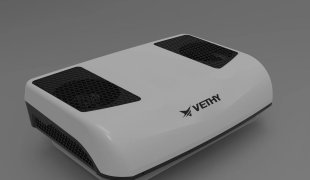R134A/R410A Refrigerant Market Transformation: A Comprehensive Deep Dive Analysis
January 06, 2025
Preface: The Paradigm Shift in Truck Parking Air Conditioning
As a veteran researcher with over two decades of experience in thermal engineering and environmental regulations, I've witnessed numerous technological transitions. However, the current transformation in the refrigerant market represents an unprecedented convergence of environmental policy, technological innovation, and economic restructuring.
The Perfect Storm of Change
The truck parking air conditioning industry is experiencing a perfect storm of transformative forces:
1.Regulatory Pressures
Increasingly stringent environmental regulations
Global commitment to climate change mitigation
Accelerating phase-out of high-GWP refrigerants
2.Technological Revolution
Breakthrough in low-GWP refrigerant technologies
Advanced materials and system design
Artificial intelligence and predictive maintenance
3.Economic Imperatives
Long-term cost optimization
Energy efficiency as a competitive advantage
Investment in sustainable technologies
Comprehensive Market Landscape Analysis
Global Refrigerant Market Visualization
Detailed Regional Breakdown
North America (28% Growth)
Market Size: $2.8 Billion
Key Drivers:
Stringent EPA regulations
Technological innovation ecosystem
High adoption of sustainable technologies
Europe (32% Growth)
Market Size: $2.1 Billion
Unique Characteristics:
Aggressive F-Gas regulations
Strong policy support for green technologies
Integrated approach to environmental compliance
Asia Pacific (25% Growth)
Market Size: $3.4 Billion
Emerging Trends:
Rapid industrialization
Growing environmental consciousness
Significant investments in R&D
Rest of World (20% Growth)
Market Size: $1.2 Billion
Challenges and Opportunities:
Varying regulatory environments
Technology transfer challenges
Potential for leapfrog innovations
Refrigerant Performance: A Comprehensive Comparative Analysis
Detailed Performance Metrics
Refrigerant Characteristics Comparison

Performance Evaluation Framework
Global Warming Potential (GWP)
Critical environmental metric
Lower values indicate reduced climate impact
Regulatory compliance depends on GWP thresholds
Cooling Efficiency
Direct impact on energy consumption
Higher efficiency translates to lower operational costs
System design plays crucial role
Safety Classification
Determines installation and handling requirements
Influences insurance and operational costs
Critical for risk management
Market Transition Cost Structure
Detailed Cost Breakdown and Strategic Implications
Cost Distribution Analysis
Equipment Replacement: 40% ($1.2 Billion)
Hardware upgrades
System redesign
Compatibility modifications
Training & Certification: 25% ($0.75 Billion)
Technical skill development
Safety protocol training
Compliance education
Infrastructure Updates: 20% ($0.6 Billion)
Facility modifications
Testing and validation infrastructure
Retrofitting existing systems
Safety Systems: 15% ($0.45 Billion)
Advanced monitoring technologies
Risk mitigation systems
Emergency response capabilities
Strategic Roadmap for Stakeholders
For Manufacturers: Innovation and Adaptation Strategies
R&D Investment Prioritization
Develop low-GWP refrigerant solutions
Create modular, adaptable system designs
Invest in predictive modeling technologies
Product Portfolio Transformation
Phased retirement of legacy systems
Develop next-generation refrigerant technologies
Create flexible, future-proof product lines
Collaborative Innovation
Academic partnerships
Cross-industry technology exchanges
Open innovation platforms
For Fleet Operators: Risk Mitigation and Optimization
Comprehensive Transition Planning
Develop multi-year refrigerant transition roadmap
Conduct thorough system audits
Create financial models for technology replacement
Technology Investment Framework
Prioritize energy-efficient solutions
Consider total cost of ownership
Build flexibility into procurement strategies
Workforce Development
Continuous technical training programs
Create internal certification mechanisms
Develop cross-functional technical skills
For Service Providers: New Value Propositions
Service Model Innovation
Develop specialized refrigerant transition services
Create comprehensive diagnostic packages
Build predictive maintenance capabilities
Technology Ecosystem Development
Invest in advanced diagnostic tools
Create training and certification programs
Develop digital service platforms
Market Opportunity Landscape

Future Outlook and Projections
Technology Adoption Forecast

Key Performance IndicatorsProjected Market Growth: 28% CAGR through 2026
Total Industry Investment: $8.5 Billion by 2025
New Job Creation: 45,000+ Specialized Positions
Estimated Carbon Reduction: 3.2 Million Metric Tons CO2 Equivalent
Conclusion: Navigating the Transformation
The refrigerant market stands at a critical inflection point. This transformation transcends mere technological replacement—it represents a fundamental reimagining of thermal management technologies.
Critical Success Factors
Proactive Adaptation
Anticipate regulatory changes
Invest in forward-looking technologies
Build organizational agility
Strategic Investment
Prioritize long-term value creation
Balance short-term costs with future opportunities
Develop comprehensive investment strategies
Continuous Innovation
Foster a culture of technological exploration
Encourage cross-functional collaboration
Invest in continuous learning
Holistic Workforce Development
Create adaptive training ecosystems
Develop multi-disciplinary skills
Build resilient organizational capabilities
Final Insight: Companies that view this transition not as a compliance challenge but as a strategic opportunity will emerge as industry leaders.
Disclaimer: This analysis is based on comprehensive market research and forward-looking projections. Actual outcomes may vary due to unforeseen technological, regulatory, and market dynamics.





